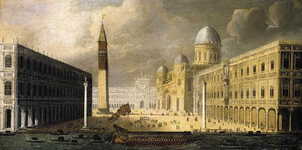François de Nomé
Paintings
Fantastic Ruins with Saint Augustine and the Child
St Paul Preaching to the Athenians
Venice a view of San Marco from the Bacino

Head of Saint John the Baptist Presented to Salome





King Asa of Juda Destroying the Idols

A Fantastic Architectural View

Entry of Christ into Jerusalem


Architectural Capriccio with Christ and Disciples

Belisarius Recognized by one of his Soldiers

View of Metz from the hill Bellecroix ("view of Jerusalem")
---
Fine Art Prints | Greeting Cards | Phone Cases | Lifestyle | Face Masks | Men's , Women' Apparel | Home Decor | jigsaw puzzles | Notebooks | Tapestries | ...
Fantastic Ruins with Saint Augustine and the Child
François de Nomé (1593 – after 1620) was a French painter of the Baroque period, active mainly in Naples.
Biography
Born in Metz in the Lorraine region in 1593, de Nomé had moved to Rome by 1602 [1] where he worked in the workshop of Balthasar Lawars until around 1610[2] after which he moved to Naples.[1]
Until the mid-twentieth century de Nomé's works were believed to be by one "Monsù Desiderio". However the works formerly attributed to Desiderio have since been identified as the work of at least three artists: de Nomé, Didier Barra, who was also from Metz, and a third, as yet unnamed painter.[1] The figures in de Nomé's works were painted by other artists, including Belisario Corenzio and Jacob van Swanenburgh.[2]
The themes are bizarre, typically decrepit ruins or near-barren buildings in a nearly-surrealist, apparently post-apocalyptic landscape. People are tiny figures, skies overcast, tonalities earthen, and edges indistinct. His depiction of Venice's Piazza di San Marco is correctly populated by the appropriate structures, but the details are all invented.
The style was not highly influential for Italian painters of landscapes (veduta) in the next century, with the exception of perhaps Alessandro Magnasco. However, the depictions of nightmarish wilderness amidst the detritus of civilization was a thematic adopted by painters such as Salvatore Rosa and Michelangelo Cerquozzi, and reappears in the capricci (whimsical and fantastic monuments, ruins, or buildings) of Piranesi.
References
Wittkower, Rudolf (1973) [1958]. Art and Architecture in Italy. The Pelican History of Art (First Paperback ed.). Harmondsworth: Penguin Books.
Painting in Naples 1606-1705: From Carravaggio to Giordano. Exhibition catalogue. London: The Royal Academy of Arts. 1982.
Web Gallery of Art Biography
----
Fine Art Prints | Greeting Cards | Phone Cases | Lifestyle | Face Masks | Men's , Women' Apparel | Home Decor | jigsaw puzzles | Notebooks | Tapestries | ...
----
Artist
A - B - C - D - E - F - G - H - I - J - K - L - M -
N - O - P - Q - R - S - T - U - V - W - X - Y - Z
Retrieved from "http://en.wikipedia.org/"
All text is available under the terms of the GNU Free Documentation License





